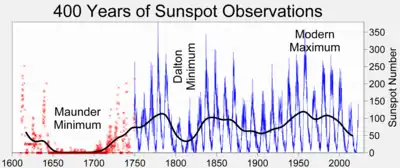The Modern Maximum, also called the Solar Modern Maximum, refers to a period of intensifying solar activity during one solar cycle.[1] In essence, the Sun undergoes a cycle every 11 years, and during this cycle, the Sun will generally have a large increase in activity, which is why it is known as the Solar Modern Maximum, which produces higher energy outputs, solar eruptions, and a large number of sunspots.[1] As new reports are released, scientists suggest that the modern solar maximum could be a larger part of Earth's ongoing climate change than what was once thought.

Solar cycle
Much information is still unknown; however, researchers have come to a more recent conclusion as to why the Sun may experience these moments of intensity during the Solar Modern Maximum. Recent studies state that during the Modern Maximum event, scientists recorded that the Sun's magnetic poles will begin to flip and eventually reverse completely, and throughout the change in polarity, the Sun will start to experience microbursts of energy due to the changes within its very large magnetic field.[1] The main concern with the changes in polarity is the degree to which it affects the Sun's total solar irradiance, which is a measure of the total energy that is produced from its luminosity. Given that the Earth relies on this energy source in order for life to thrive, major changes could be detrimental.[2] However, recent reports have stated that the changes in solar irradiance experienced in these short cycles are often minimal, equivalent to a change of 0.15% in most cases. This leads scientists to believe that these short periods of time will not greatly affect the overall greenhouse effect, although these short cycles over long periods of time could have measurable impacts.[1]
This maximum period is a natural example of solar variation, and one of many that are known from proxy records of past solar variability. The Modern Maximum reached a double peak once in the 1950s and again during the 1990s. For example, scientists theorized that the Modern Solar Maximum which occurred in 1950-1980 brought a significant cooling phase through parts of the North Atlantic region with Greenland experiencing a major cooling cycle.[3]
Effects on the Earth
The modern solar maximum could be a larger part of Earth's ongoing climate change than once thought. To start, Greenland has an ongoing project known as the Greenland ice core project, which is designed to represent the possible temperature variations that Greenland has experienced over thousands of years.[3] Scientists use argon and nitrogen isotopes trapped within air pockets to collect data on temperature fluctuations during certain periods.[3] Using this method, scientists found a series of data that suggests solar variability within the Sun's modern maximum cycles could have been the main cause of the great cooling that Greenland experienced from 1970 to 1990.[3] After taking a look at previous solar records, it was found that between 1950 and the early 1980s the Sun had experienced very high solar activity during the modern maximum cycle.[3]
This leads many researchers to suggest that higher solar activity could relate to larger cold spells which could be experienced either globally or throughout smaller regions. To test this theory, data needs to be collected that can indicate when the Sun will begin to enter a cycle of high or low solar activity this way temperature fluctuations can be tested and recorded. One-way scientists have recorded different solar cycles is by examining sunspots that are currently on the star and comparing them with earlier known sunspot occurrences.[4] For example, the largest known recorded number of sunspots on the Sun was during the 20th century, and these values have not been seen since the late 18th century.[4] Also, as mentioned earlier Greenland had experienced a very large cold spell at the time of this solar cycle.[3]
 Ice sheets much like this one can be found throughout locations such as Greenland, and many scientists speculate that solar activity could be a cause of the cooling cycles that form these large structures.
Ice sheets much like this one can be found throughout locations such as Greenland, and many scientists speculate that solar activity could be a cause of the cooling cycles that form these large structures.
References
- Lean, J. L. (April 2018). "Estimating Solar Irradiance Since 850 CE". Earth and Space Science. 5 (4): 133–149. Bibcode:2018E&SS....5..133L. doi:10.1002/2017EA000357. S2CID 125680439.
- 1 2 3 4 Hatfield, Miles (2020-05-22). "FAQ: How Does the Solar Cycle Affect Earth's Climate?". NASA. Retrieved 2023-04-20.
- ↑ "NASA - SOLAR IRRADIANCE". www.nasa.gov. Retrieved 2023-04-20.
- 1 2 3 4 5 6 Kobashi, T.; Box, J. E.; Vinther, B. M.; Goto-Azuma, K.; Blunier, T.; White, J. W. C.; Nakaegawa, T.; Andresen, C. S. (2015-07-28). "Modern solar maximum forced late twentieth century Greenland cooling: SOLAR MAXIMUM FORCED GREENLAND COOLING". Geophysical Research Letters. 42 (14): 5992–5999. doi:10.1002/2015GL064764. S2CID 53577049.
- 1 2 Lean, J. L. (March 2018). "Estimating Solar Irradiance Since 850 CE". Earth and Space Science. 5 (4): 133–149. Bibcode:2018E&SS....5..133L. doi:10.1002/2017EA000357. S2CID 125680439.